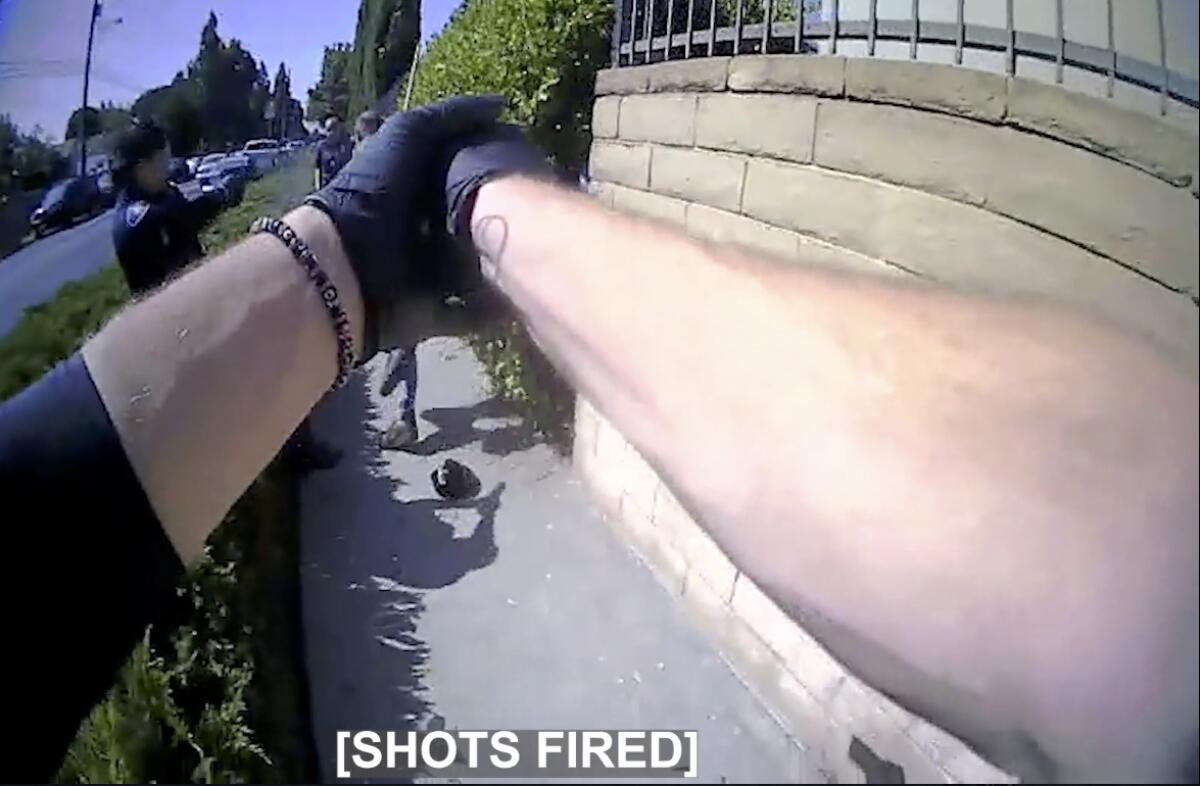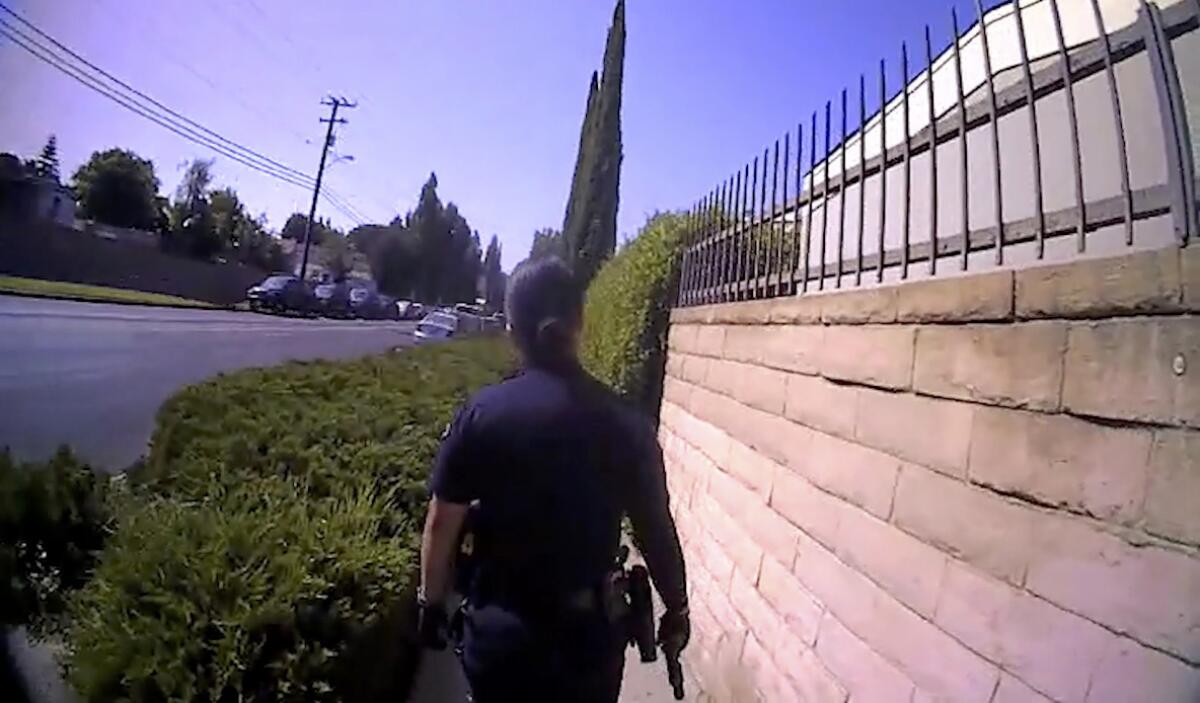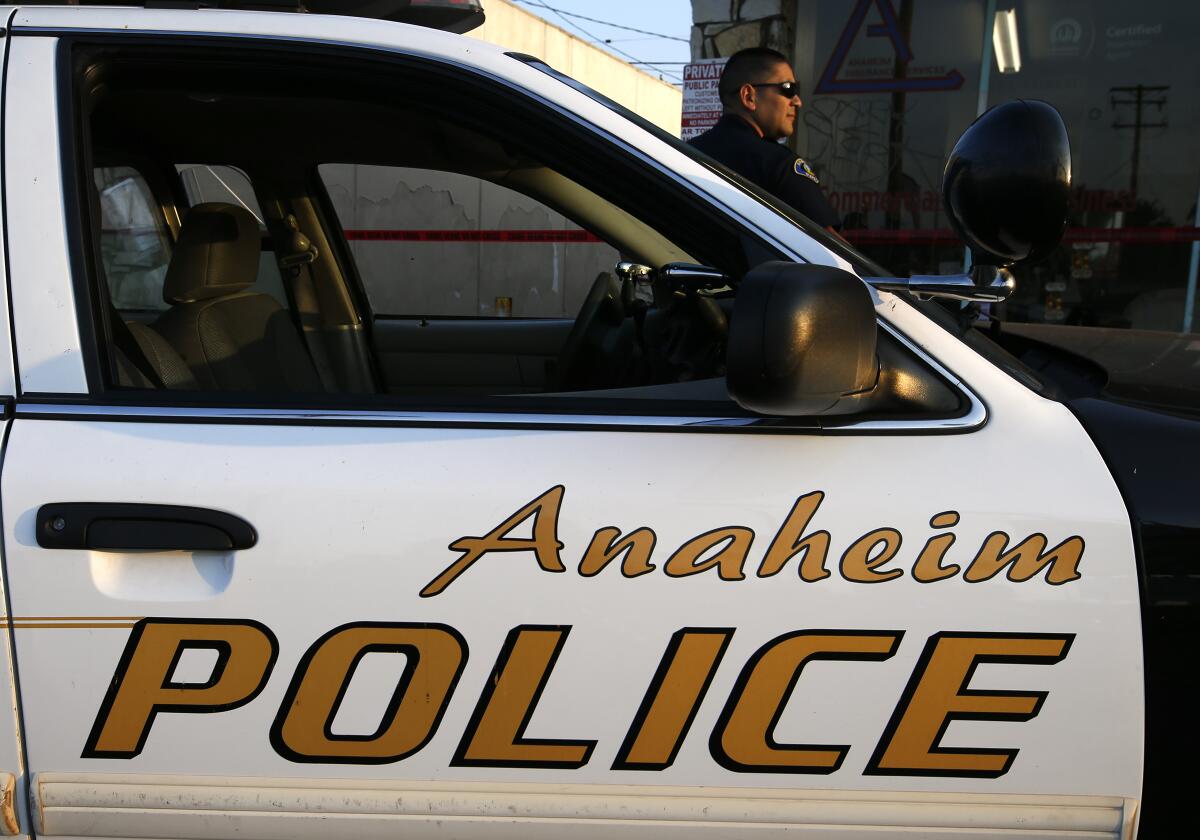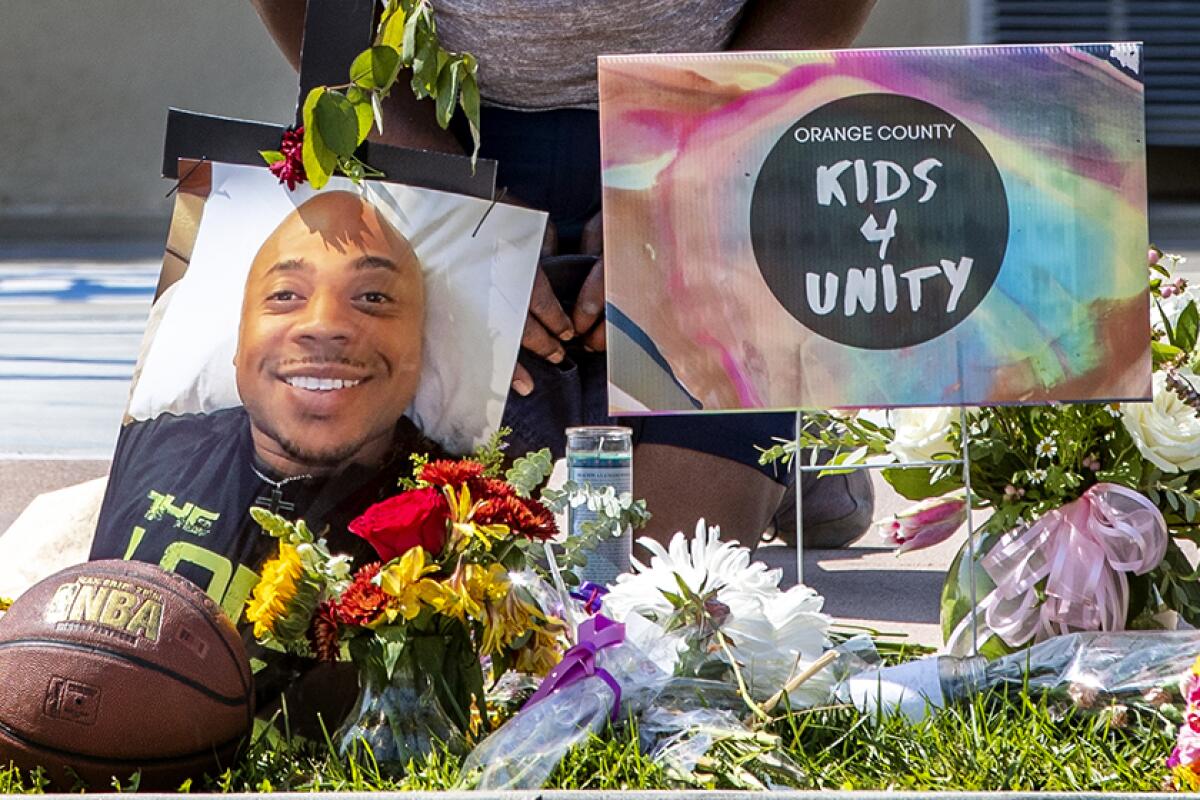Body camera footage sheds light on Tustin police shooting of homeless man

- Share via
Newly released body camera footage released by Tustin police sheds new light on the fatal police shooting of a homeless man who reportedly was suffering from mental health issues.
The footage also reveals how quickly the situation escalated before Luis Manuel Garcia was killed on Aug. 9 near a mobile home community. The time from when the officers first made contact with Garcia to when the fatal gunshots were fired lasted one minute and 17 seconds.
The California Department of Justice is investigating the shooting under Assembly Bill 1506, which requires the department to investigate all police shootings resulting in the death of an unarmed civilian in the state. Orange County Dist. Atty. Todd Spitzer’s office is assisting with the investigation.
Tustin police spokeswoman Stephanie Nichols confirmed this week that Estella Silva is the officer who fired the fatal rounds, and all the officers involved in the shooting are still out in the field.
Nichols said she could not comment on the case due to the fact that it could interfere with the state DOJ and D.A. investigations.
Garcia’s family has filed a claim for damages against the city in the names of his 12-year-old and 18-year-old daughters. Rosalia Becerra, Garcia’s former partner of about 15 years, said she wants to see Silva punished for the shooting.
“We want justice for him and for my girls,” Becerra said. “She took away the possibility of my girls having a father. She took away the opportunity for him to get out of the hole that he was in. We want to see justice. We want to see her behind bars. That’s what we’re looking for.”
The recently released footage from the police department begins with a call from a resident that led to the police response. The caller reports that her neighbor had seen a homeless man two days prior living in the bushes near the Saddleback Mobilodge community at 15401 Williams St. She says he had a “big, huge steak knife.”
When the dispatcher asks if the woman had seen the knife that day and whether he was holding or pointing it at people, the resident says she last saw him with the knife the day before and he was “swinging his hands, and walking around and talking to himself.” The resident describes the homeless man as a white male in his 30s with blond hair.
The footage then shows the police response to the mobile home park around 10 a.m.
The video shows Silva walking up to the bushes, telling Garcia to wake up and come out with his hands up. She points what looks like a gun at him. Another officer, who supplied the body cam footage, is right behind Silva. “OK,” Garcia responds. Silva says she knows Garcia.
“Let’s go, come on, get out!” Silva yells at Garcia, then tells him to keep his hands up.
Meanwhile, Garcia responds to Silva, but the video’s subtitles say it’s unclear what he is saying. Garcia isn’t in view of the camera.
“Let’s go, over here,” Silva says in English and Spanish.
“OK, let me out,” Garcia responds in Spanish.
Silva is blocking the area where Garcia would be able to exit from the bushes. Silva moves back a bit and says “Let’s go, keep your hands up,” an order repeated by the second officer.
Silva tells a third officer to go down the sidewalk. He responds, “Yeah, just watch your crossfire.”
Garcia continues to ask the officer to let him out. Silva forcefully tells Garcia in Spanish to “show me your hands right now.”

“Look, I’m showing them,” Garcia says.
As Silva continues to tell him to exit the bushes, Garcia asks, “Why are you getting me?” and “Why are you going to take me?”
Then Silva says, “Dude, I’m going in” and begins to go through the bushes to get to Garcia. The officer behind Silva tells her to hold on. She stops and continues to yell at Garcia, “Let’s go now!”
Garcia says that he’s collecting recyclables, but as Silva continues her commands, Garcia starts walking out of the bushes.
Garcia is then given conflicting directions from Silva, who tells him to get out, and the officer behind her, who tells Garcia to face the wall, before he was out of the bushes.
“I’m doing recyclables, hey, don’t hit me,” Garcia says in Spanish as the officers grab for him. He ducks back into the bushes as they reach for him.
“He’s got a stick,” the officer with Silva says repeatedly, though Garcia is not visible.
Silva immediately steps back, unholsters her gun and tells Garcia to get his hands up. Silva aims her gun at Garcia and the other officer trains his stun gun on him. “Why are you going to hit me?” Garcia says.
As Garcia exits the bushes, he says, “Go ahead, go ahead hit me.” The officer fires the stun gun at Garcia, who has a plastic bag in the same hand as a long, skinny stick-like object. As the stun gun deploys, Garcia yells and steps back into the bushes. Then as he steps forward, Silva fires two shots at him. Garcia drops his stick and tries to run but is thrown into the bushes by the third officer.
The footage then cuts out and comes back in after Garcia is handcuffed and on the ground. He is still conscious at this point.
When Silva asks whether he still has a knife, Garcia responds, “Everything is fine.”
“Everything is going to be OK,” Garcia says. “It hurts me. It hurts me. It hurts me. It hurts me.”
As the officers tend to Garcia, he moans aloud. The footage cuts out shortly after and says that Garcia was transported to a local hospital, where he died from his injuries.
Police said in the video that Garcia had a wooden pole with him. The footage also includes several police photos of the pole, which has no sharp edges on it.
Nichols said she could not comment on whether a knife was found on Garcia or at the scene of the incident due to the ongoing investigations. No knife is shown in the video, only the pole.

Tustin police’s initial description of the incident said that the department received a call from a local resident about a suspicious male, but it failed to mention that the resident described a man who didn’t fit Garcia’s description. Police also didn’t mention that the resident was reporting an incident from days prior. In describing what led up to the shooting, Tustin police said that the “suspect quickly came out of the bushes, advancing on the officers.”
“There’s too many things that don’t add up,” Becerra said about the footage. “To begin with, the person that made the call described him as somebody else. She describes him as a white male. He’s not white, he’s Hispanic. She also mentions he has white hair. He had no hair. So to me right there, she’s describing a different person.”
Becerra pointed out how the woman referenced last seeing a man with a knife a day before.
“So even at the time when this person makes a call, the person that she’s talking about is not even a threat to the community at the time,” Becerra said. “She’s talking about an incident that happened a couple of days before.”
Becerra also said that Garcia was sleeping when officers approached him, so he was visibly not a threat. She also said that because he’s just been awakened by police, Garcia is likely confused and scared, and then Silva was being “very rude.”
Becerra said Garcia normally had the stick because he used it to pick up recyclables from big dumpsters. She said he didn’t let go of his stick or bag in the footage likely because he relied on them. She also said that he wasn’t using the stick in a violent or threatening manner. He didn’t point the stick at the officers or attempt to swing it, she said.
“Maybe it’s gold to him,” Becerra said. “He eats off of the recyclables. He sells it to live off of that.”
She continued: “There was no need for for her to shoot her gun after he was Tased. There was three officers... with one person with a stick. Really? You thought a stick was going to kill you? He didn’t even make any move to make them think that he was a threat.”
A spokesperson for California Atty. Gen. Rob Bonta’s office declined to provide comment due to the ongoing investigation. District attorney’s office spokeswoman Kimberly Edds said all requests for comment should be directed to the attorney general “as it is their investigation.”
Michael Carrillo, an attorney representing Garcia’s family, said over the phone that the shooting was unjustified.
“There was no threat that he was going to hit her with a stick or with a pole,” Carrillo said. “There had been a call about a knife a day before. So to resort to deadly force so quickly, I felt was just so inappropriate. I mean, this is a mentally ill man and they should have handled him with more care.”
Carrillo said they suspect Garcia suffered from some form of schizophrenia, but they don’t have a medical diagnosis. Becerra said Garcia talked to himself, but he never showed any violent behavior.
Becerra said Garcia’s mental health issues started worsening after he became homeless after their relationship ended about six years ago. Becerra said that she kept in touch with Garcia while he was homeless because of their daughters. The family tried to help him, but he wanted to do things on his own.
“He was like a friend, somebody you can joke around with all the time,” Becerra described him. “He was very lovable. He was very caring for his girls. He used to love them so much, they were his world.
“We used to go on a walk every day in the afternoon after coming home from work. We would take our girls to the park every weekend. We would go to Disneyland every year. He was just very fun to be around with. He was a very happy person too. He was a good dad, a good partner. We were good for so long.”
Becerra said their relationship ended after Garcia started hanging around with “a bad crowd” of friends.
Becerra currently lives in Palmdale with her and Garcia’s 18-year-old and 12-year-old daughters, who are named in a claim that the family filed with the city of Tustin in September. Carrillo said they have not received a response from the city, and the next step is to file a federal civil rights lawsuit against the city, most likely before the end of the year.
“It hasn’t been easy for them, the whole process, having to bury their dad,” Becerra said of her kids. “Now that the video came up, I’m just trying to kind of keep them away from the social media. I’m just trying to really protect as much as I can from them.”
Jennifer Rojas, policy advocate and organizer with the American Civil Liberties Union of Southern California, said Garcia’s death was a “tragic loss” and another example of excessive force being used against people experiencing homelessness and mental illness.
“When police shoot and kill someone who is experiencing homelessness or mental illness, it really just makes super clear the systemic failure of our community to provide social services that would have benefited Luis Manuel Garcia, like supportive housing and mental health treatment,” Rojas said. “When it comes to people experiencing homelessness and mental illness, police do not make our community safer.”

Rojas pointed to the fact that AB 1506 took effect in July, and the state is already investigating two cases of unarmed civilians killed by police in Orange County. The other case is the Anaheim police killing of Brandon Lopez, who was the cousin of Santa Ana Councilman Johnathan Hernandez. Lopez was killed on Sept. 28 after a car chase and hours-long standoff with police at a construction area on Santa Ana Boulevard in Santa Ana. Lopez was allegedly driving a stolen car and was wanted for armed robberies. Similar to Garcia, Hernandez has said Lopez was suffering from a mental health crisis and Anaheim police unnecessarily escalated the situation. Santa Ana Mayor Vicente Sarmiento criticized police for acting like “a firing squad” in Lopez’s shooting.
A week after the killing, the Santa Ana City Council unanimously approved a contract with homeless service provider CityNet to provide street outreach and care to homeless people, particularly those suffering with mental illness. The pilot program will steer these calls for service away from the police department.
Many Orange County cities have been adopting similar programs in order to free up police and decrease violent confrontations between law enforcement and people with mental health issues.
“It really just draws a bright light on how much police violence is happening in Orange County, and why we need more programs that effectively remove police from responding to these types of calls,” Rojas said.
Many have criticized police responses to mental health calls because officers may lack the expertise to deescalate tense situations. Often, the sight of a law enforcement officer can aggravate a person suffering with mental health issues, they say. Besides the shooting of Lopez and Garcia, this perspective hit close to home again last year when Kurt Reinhold, a homeless Black man with mental health issues, was shot and killed during a confrontation with Orange County sheriff’s deputies in San Clemente. The incident provoked outrage similar to the highly publicized Fullerton police killing of Kelly Thomas, a schizophrenic man who was beaten to death a decade ago.

Orange County isn’t alone contending with the issue. Since the killing of George Floyd more than a year ago, many have called for police to refrain from engaging in mental health calls. Los Angeles has been working on using trained specialists to respond to calls instead of law enforcement.
Cities are pursuing these teams in a few different ways. Fullerton and Buena Park are partnering together in an effort known as Project HOPE.
Another method being considered by some cities is the use of mobile response teams provided by Be Well OC, which provides mental health support to county residents. It runs the first mental health and wellness campus in Orange County. Huntington Beach and Garden Grove have chosen to partner with Be Well OC to implement the response teams. Irvine is currently exploring the program and figuring out how best to integrate it into the city’s current health response system. Several other Orange County cities are considering the teams.
Nichols said Tustin is considering “every option out there” right now for the mobile response teams, including the Be Well OC program.
Rojas said these teams could help prevent police violence against people suffering from homelessness or mental illness.
“Cities should really be uplifting those types of programs,” Rojas said. “Too often when police show up, as we saw in this body camera footage, police escalated the situation.
“I just wonder what it would have looked like if a social service provider, mental health worker or health clinician showed up to respond to that call, instead of police. I think it would have resulted in a much better outcome.”
All the latest on Orange County from Orange County.
Get our free TimesOC newsletter.
You may occasionally receive promotional content from the Daily Pilot.




